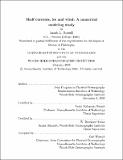| dc.contributor.advisor | Paola Malanotte-Rizzoli and Breckner Owens. | en_US |
| dc.contributor.author | Russell, Sarah L. (Sarah Louise), 1973- | en_US |
| dc.contributor.other | Woods Hole Oceanographic Institution. | en_US |
| dc.date.accessioned | 2007-10-19T21:05:23Z | |
| dc.date.available | 2007-10-19T21:05:23Z | |
| dc.date.copyright | 2003 | en_US |
| dc.date.issued | 2003 | en_US |
| dc.identifier.uri | http://hdl.handle.net/1721.1/39225 | |
| dc.description | Thesis (Ph. D.)--Joint Program in Physical Oceanography (Massachusetts Institute of Technology, Dept. of Earth, Atmospheric, and Planetary Sciences, and the Woods Hole Oceanographic Institution), 2003. | en_US |
| dc.description | This electronic version was submitted by the student author. The certified thesis is available in the Institute Archives and Special Collections. | en_US |
| dc.description | Includes bibliographical references (p. 190-197). | en_US |
| dc.description.abstract | In this thesis, the effects of sea ice, downwelling favorable winds and barotropic background currents on shelf fronts are examined using numerical models. The models are configured with the characteristics of the East Greenland Current, north of the Denmark Strait, in mind. While the models are heavily idealized, basic physical parameters match the observed ocean. The first part of the thesis uses a three dimensional, primitive equation model to examine the behavior of a shelf front under steady, along shelf winds and barotropic currents. The wind stress generates shoreward surface Ekman transport and the barotropic current generates an offshore bottom Ekman transport. In both cases, the Ekman transport causes the creation of mixed layers and a relationship describing the mixed layer thickness is derived relating the cross shelf flux of density to the along shelf flux of density. When there is a barotropic inflow, the cross shelf Ekman mass transport is balanced by a return flow of mass in the interior. When there is a wind stress, in the present model configuration, the influence of the offshore boundary obscures the effect of the Ekman layers. The second part of the thesis focuses on the ice-ocean interaction using a simple, two layer, one dimensional toy model. The interaction of sea-ice, geostrophic currents, and wind are examined. In the presence of a current and the absence of wind, the ice is transported downstream with the current. In the presence of wind and the absence of a current, the net ice-ocean transport is perpendicular to the wind, as is expected for Ekman layer theory. The two layer system acts like a poorly resolved Ekman spiral: the ice has down wind and shoreward transport while the ocean has up wind and shoreward transport. | en_US |
| dc.description.statementofresponsibility | by Sarah L. Russell. | en_US |
| dc.format.extent | 197 p. | en_US |
| dc.language.iso | eng | en_US |
| dc.publisher | Massachusetts Institute of Technology | en_US |
| dc.rights | M.I.T. theses are protected by copyright. They may be viewed from this source for any purpose, but reproduction or distribution in any format is prohibited without written permission. See provided URL for inquiries about permission. | en_US |
| dc.rights.uri | http://dspace.mit.edu/handle/1721.1/7582 | |
| dc.subject | Joint Program in Physical Oceanography. | en_US |
| dc.subject | Earth, Atmospheric, and Planetary Sciences. | en_US |
| dc.subject | Woods Hole Oceanographic Institution. | en_US |
| dc.title | Shelf currents, ice and wind : a numerical modeling study | en_US |
| dc.type | Thesis | en_US |
| dc.description.degree | Ph.D. | en_US |
| dc.contributor.department | Joint Program in Physical Oceanography | en_US |
| dc.contributor.department | Woods Hole Oceanographic Institution | en_US |
| dc.contributor.department | Massachusetts Institute of Technology. Department of Earth, Atmospheric, and Planetary Sciences | |
| dc.contributor.department | Massachusetts Institute of Technology. Department of Ocean Engineering | |
| dc.identifier.oclc | 52711351 | en_US |
